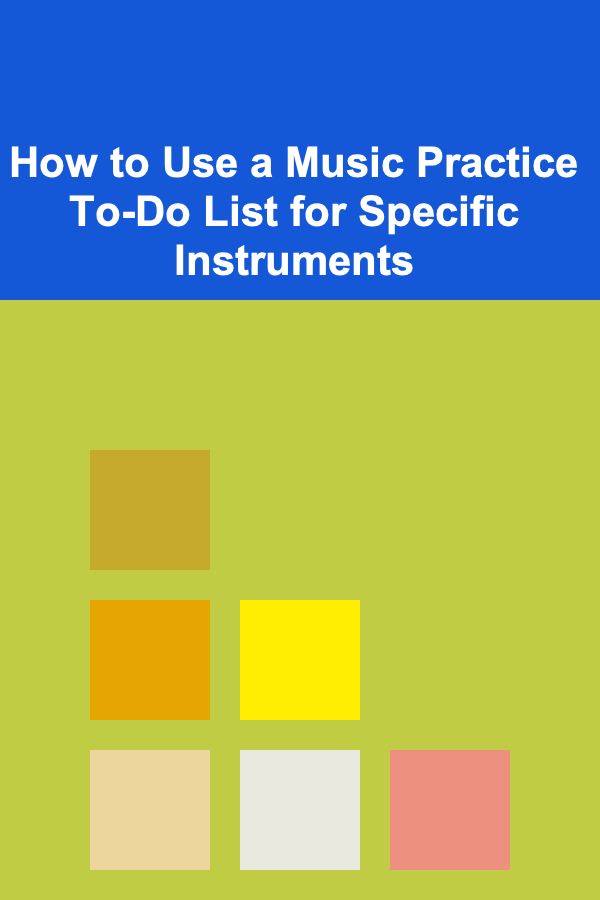
How to Use a Music Practice To-Do List for Specific Instruments
ebook include PDF & Audio bundle (Micro Guide)
$12.99$5.99
Limited Time Offer! Order within the next:

Music practice is an essential aspect of improving your musical skills, regardless of the instrument you play. One of the most effective ways to organize and optimize your practice sessions is through the use of a To-Do list. This list can be tailored specifically for your instrument, ensuring that every practice session is purposeful and contributes to your growth as a musician. Whether you are learning piano, guitar, violin, or any other instrument, a well-structured To-Do list can make a huge difference in your progress.
In this article, we'll explore how to create and use a music practice To-Do list specifically for different instruments. We'll dive into the benefits of using a To-Do list, how to break down your practice sessions, and tips for staying consistent and motivated.
Why Use a Music Practice To-Do List?
Before diving into how to build a To-Do list, let's first understand why using one is beneficial for musicians. Here are some reasons:
1. Organizes Your Practice Time
Creating a To-Do list forces you to plan out what you'll focus on in each practice session. This helps prevent aimless playing or repetitive practice of the same material, ensuring you're improving in all the necessary areas.
2. Tracks Progress
As you check off tasks from your list, you get a sense of accomplishment, and you can track your improvement over time. This feeling of progress keeps you motivated to continue practicing.
3. Helps Focus on Weak Areas
A To-Do list can highlight the areas where you're struggling, prompting you to dedicate more time to those aspects of your instrument. By identifying and working on weak spots, you can improve faster.
4. Customizable for Any Instrument
Whether you play piano, guitar, violin, or any other instrument, your To-Do list can be tailored specifically to suit the demands of that instrument. Each list will reflect the unique challenges and techniques specific to your musical goals.
Now, let's break down how to create and use a music practice To-Do list for specific instruments.
How to Create a Music Practice To-Do List for Different Instruments
1. Piano
Piano practice involves a mix of technique, theory, repertoire, and improvisation. Here's how you can create a comprehensive To-Do list for piano practice:
a) Warm-Up Exercises
Start with basic warm-up exercises to prepare your hands and fingers. These might include:
- Five-finger scales (playing all five notes of a scale with each hand).
- Major and minor scales (playing scales in different keys).
- Arpeggios (playing the notes of a chord one at a time).
- Hanons or Czerny exercises for finger strength and coordination.
b) Technique Practice
Dedicate time to specific technical skills, such as:
- Sight-reading practice (reading a new piece of music).
- Hand coordination (playing with both hands at once or playing difficult hand patterns).
- Dynamics practice (working on loud and soft playing).
c) Repertoire
Your To-Do list should include pieces you're currently working on. Break each piece into smaller sections and focus on:
- Specific measures (targeting difficult passages).
- Tempo (playing slower than the intended tempo to master difficult sections).
- Expression and dynamics (adding emotion to your playing).
d) Theory and Ear Training
Theory and ear training are key to becoming a well-rounded musician. Include exercises such as:
- Chord progressions (identifying and playing common progressions).
- Interval recognition (learning to recognize the distance between two notes).
- Transcribing music (listening to a piece and writing it down by ear).
Example of a Piano To-Do List:
- Warm-Up: Scales and Arpeggios (5 minutes)
- Technique: Hanon Exercise #1 (10 minutes)
- Repertoire: Beethoven's Sonata Op. 13, 1st Movement (20 minutes)
- Sight-Reading: 2 pages from a new piece (10 minutes)
- Theory: Practice chord progressions (5 minutes)
2. Guitar
Guitar practice can involve finger exercises, chord work, scale knowledge, and repertoire development. Here's how to structure a To-Do list for guitar practice:
a) Warm-Up Exercises
Begin your practice with finger exercises to loosen up and improve finger strength. Some common exercises for guitar include:
- Chromatic scales (playing each fret across strings).
- Alternate picking exercises (to increase picking speed and accuracy).
- Stretching exercises (to improve reach and dexterity).
b) Chord and Scale Practice
Mastering chords and scales is vital for any guitarist. Include tasks such as:
- Learning new chords (major, minor, and seventh chords).
- Scale exercises (major, minor, pentatonic, blues scales).
- Chord transitions (working on smooth transitions between difficult chord changes).
c) Repertoire
Include songs or guitar solos you're working on. Break them into manageable sections:
- New song learning (breaking the song into phrases).
- Solo practice (working on fast, intricate solos).
- Riff practice (learning famous guitar riffs).
d) Theory
Guitarists benefit from understanding music theory. You can include exercises on:
- Chord construction (building chords from scales).
- Intervals (learning the distance between two notes on the fretboard).
- Improvisation (creating melodies over backing tracks).
Example of a Guitar To-Do List:
- Warm-Up: Chromatic scales (5 minutes)
- Technique: Alternate picking exercise (5 minutes)
- Chords: Practice major and minor chord changes (10 minutes)
- Repertoire: Work on "Hotel California" intro (15 minutes)
- Theory: Learn modes of the major scale (5 minutes)
3. Violin
Violin practice is deeply rooted in technique, including bowing, finger placement, intonation, and expression. Here's how to structure a To-Do list for violin:
a) Warm-Up Exercises
Violinists need to focus on bowing and left-hand exercises to get the best sound. Include:
- Long bows (working on bow control).
- Scales (both one-octave and two-octave scales).
- Shifting exercises (moving smoothly between positions).
b) Technical Exercises
Focus on improving your bowing technique and left-hand agility, such as:
- Detache bowing (smooth, detached strokes).
- Staccato bowing (short, separated strokes).
- Trills (rapid alternation between two notes).
c) Repertoire
Break down your pieces into small segments. Work on:
- Difficult passages (focus on a few measures at a time).
- Expression (dynamics and phrasing).
- Intonation (ensuring notes are in tune).
d) Sight-Reading
Regular sight-reading helps improve overall musicianship, so include it on your To-Do list:
- Sight-read a new piece (focus on rhythm and overall phrasing).
- Ear training (identify intervals and melodic patterns by ear).
Example of a Violin To-Do List:
- Warm-Up: Scales in G major (5 minutes)
- Technique: Practice long bows (10 minutes)
- Repertoire: Work on "Meditation" from Thaïs (15 minutes)
- Sight-Reading: Read through a new piece (10 minutes)
- Theory: Learn to build diminished chords (5 minutes)
4. Other Instruments
For other instruments like flute, trumpet, drums, and saxophone, the approach is largely the same but tailored to the specific needs of each instrument. Whether you're working on breathing techniques for wind instruments, drumming rudiments, or specific orchestral parts, a To-Do list can help you focus on:
- Basic exercises to develop technique.
- Repertoire that challenges you.
- Theory and ear training to become a more well-rounded musician.
Tips for Staying Consistent and Motivated
- Set small, achievable goals: Break your practice goals down into small, manageable tasks. For instance, instead of just practicing scales, aim to master a specific scale for a set amount of time.
- Use a timer: Time your practice sessions to maintain focus. Work in focused intervals (e.g., 25-minute sessions with 5-minute breaks) to prevent burnout.
- Track progress: Keep a record of your To-Do lists and check off tasks as you complete them. This will keep you motivated by showing your growth.
- Celebrate small wins: Celebrate the completion of difficult tasks or improvements in your playing. This can be a great motivator to keep going.
Conclusion
A music practice To-Do list is a powerful tool for musicians of all levels, helping to organize, prioritize, and track progress in practice sessions. By breaking down your practice time into specific tasks related to your instrument, you can ensure that every session is purposeful and efficient. Whether you play piano, guitar, violin, or any other instrument, a well-structured To-Do list will enhance your skills and keep you motivated to continue improving.
Reading More From Our Other Websites
- [Star Gazing Tip 101] Science Explained: How the Northern Lights Are Formed
- [Organization Tip 101] How to Organize Your Favorite Recipes for Easy Access
- [Digital Decluttering Tip 101] Taming the Digital Mess: Proven Strategies to Declutter Your Devices
- [Organization Tip 101] How to Properly Wire and Install LED Recessed Lighting Fixtures
- [Personal Care Tips 101] How to Use a Facial Scrub to Help Reduce Acne Scars
- [Tie-Dyeing Tip 101] From Classic Swirls to Modern Geometry: Tie-Dye Patterns That Push Creative Boundaries
- [Home Budget Decorating 101] How to Create a Farmhouse Style Home Without Overspending
- [Organization Tip 101] How to Create a Beautifully Organized Entryway Table
- [Organization Tip 101] Eco-Friendly Bathroom: Installing a Low-Flow Toilet for Sustainable Living
- [Stamp Making Tip 101] Best Stamp Making Business: Starting & Scaling Your Personalized Stationery Venture

How to Cook for a Crowd with Ease
Read More
How to Create a Festive Foyer with Holiday Decor Ideas
Read More
How to Identify Birds by Their Behavior
Read More
How to Organize a Family Puzzle Night for Everyone to Enjoy
Read More
How to Soundproof Your Walls with Mass Loaded Vinyl
Read More
How to Make Natural Cleaning Products at Home
Read MoreOther Products

How to Cook for a Crowd with Ease
Read More
How to Create a Festive Foyer with Holiday Decor Ideas
Read More
How to Identify Birds by Their Behavior
Read More
How to Organize a Family Puzzle Night for Everyone to Enjoy
Read More
How to Soundproof Your Walls with Mass Loaded Vinyl
Read More